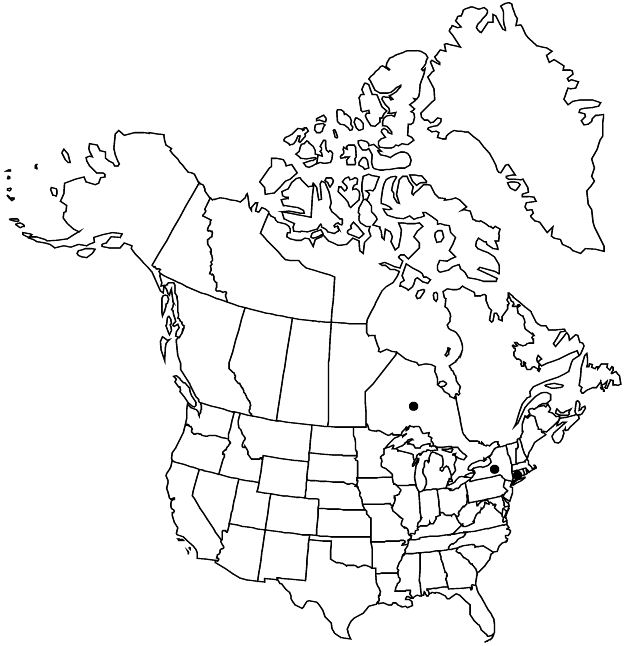Difference between revisions of "Spiraea chamaedryfolia"
Sp. Pl. 1: 489. 1753.
FNA>Volume Importer |
imported>Volume Importer |
||
| (3 intermediate revisions by 2 users not shown) | |||
| Line 28: | Line 28: | ||
|elevation=0–700 m | |elevation=0–700 m | ||
|distribution=Ont.;Conn.;N.Y.;se Europe;Asia (China;Japan;Russia);introduced also in w Europe. | |distribution=Ont.;Conn.;N.Y.;se Europe;Asia (China;Japan;Russia);introduced also in w Europe. | ||
| − | |discussion=<p>Two frequently mentioned varieties of <i>Spiraea chamaedryfolia</i> are < | + | |introduced=true |
| + | |discussion=<p>Two frequently mentioned varieties of <i>Spiraea chamaedryfolia</i> are <i></i>var.<i> ulmifolia</i> (Scopoli) Maximowicz, which has primarily ovate leaves with an obtuse base and a frequently doubly-serrate margin and inflorescences 7–10 cm diam., treated as a species by Rydberg, and var. flexuosa (Fischer ex Cambessèdes) Maximowicz, which has ovate-lanceolate leaves with cuneate base and entire or singly-serrate margin with fewer teeth and inflorescences 4–6 cm diam. Variation in the leaf and inflorescence characters is inconsistent in plants established in North America. C. Sterling (1966) described the carpel anatomy of this species but did not examine enough taxa from Europe or Asia for comparison. W. J. Bean (1970–1988, vol. 4) and H. S. Maxwell and S. G. Knees (1989) are useful references for additional information on varieties and hybrids of this Eurasian native.</p> | ||
|tables= | |tables= | ||
|references= | |references= | ||
| Line 37: | Line 38: | ||
-->{{#Taxon: | -->{{#Taxon: | ||
name=Spiraea chamaedryfolia | name=Spiraea chamaedryfolia | ||
| − | |||
|authority=Linnaeus | |authority=Linnaeus | ||
|rank=species | |rank=species | ||
| Line 53: | Line 53: | ||
|publication year=1753 | |publication year=1753 | ||
|special status=Introduced | |special status=Introduced | ||
| − | |source xml=https:// | + | |source xml=https://bitbucket.org/aafc-mbb/fna-data-curation/src/2e0870ddd59836b60bcf96646a41e87ea5a5943a/coarse_grained_fna_xml/V9/V9_690.xml |
|subfamily=Rosaceae subfam. Amygdaloideae | |subfamily=Rosaceae subfam. Amygdaloideae | ||
|tribe=Rosaceae tribe Spiraeeae | |tribe=Rosaceae tribe Spiraeeae | ||
Latest revision as of 22:58, 5 November 2020
Shrubs, 10–20 dm. Stems erect, densely branched. Leaves: petiole 5–10 mm; blade ovate to ovate-lanceolate, 4–8 × 1.5–4 cm, membranous, base obtuse, margins usually coarsely, irregularly, sharply serrate to serrulate in distal 2/3, sometimes 2-serrate, venation pinnate simple craspedodromous, secondary veins not prominent, apex acute, surfaces glaucous, glabrous. Inflorescences mostly axillary, racemiform, corymbiform, or hemispheric panicles, (2–)3–10 × 2–5 cm; branches glabrous. Pedicels 5–10 mm, glabrous. Flowers 5–12 mm diam.; hypanthia campanulate, 1.5–2 mm, abaxial surface glabrous, adaxial glabrous to puberulent; sepals ovate-triangular, 2.5–3 mm; petals white, broadly ovate, 4–6 mm, apex notched or erose; staminodes 0; stamens 35–50, 2 times petal length. Follicles asymmetrical fusiform, 2–3 mm, glabrous or pubescent. 2n = 18.
Phenology: Flowering May–Jul; fruiting Jun–Oct.
Habitat: Old pastures, homestead sites
Elevation: 0–700 m
Distribution

Introduced; Ont., Conn., N.Y., se Europe, Asia (China, Japan, Russia), introduced also in w Europe.
Discussion
Two frequently mentioned varieties of Spiraea chamaedryfolia are var. ulmifolia (Scopoli) Maximowicz, which has primarily ovate leaves with an obtuse base and a frequently doubly-serrate margin and inflorescences 7–10 cm diam., treated as a species by Rydberg, and var. flexuosa (Fischer ex Cambessèdes) Maximowicz, which has ovate-lanceolate leaves with cuneate base and entire or singly-serrate margin with fewer teeth and inflorescences 4–6 cm diam. Variation in the leaf and inflorescence characters is inconsistent in plants established in North America. C. Sterling (1966) described the carpel anatomy of this species but did not examine enough taxa from Europe or Asia for comparison. W. J. Bean (1970–1988, vol. 4) and H. S. Maxwell and S. G. Knees (1989) are useful references for additional information on varieties and hybrids of this Eurasian native.
Selected References
None.